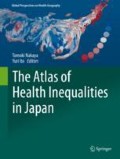Abstract
This chapter contains sections which provide background information about Japanese society and health including long-term transition of mortality, newly emergent socially vulnerable populations from the lost decades, the recent earthquake disaster whose impacts are readable in many mortality maps and social area formation in contemporary Japanese metropolitan areas. In addition, this chapter explains how to read the maps and graphs shown in later chapters. The materials and methods used to construct the health inequality atlas include the spatial unit for mapping, mortality indices with the data source and measurements of social inequalities in the mortality indices using areal deprivation index. Several analytical concepts such as the prismic cartogram, slope index of inequality and relative index of inequality are introduced.
Access this chapter
Tax calculation will be finalised at checkout
Purchases are for personal use only
References
Abe A (2018) Trends in relative poverty in Japan, 2012-2015. In: Abe A (ed) Report of MEXT KAKENHI Grant-in-Aid for Scientific Research (B) “Creating the frontier of the Science of Poverty”. Tokyo
Cabinet Office of Japan (2018) Ageing Society White Paper, 2018. Cabinet Office of Japan. https://www8.cao.go.jp/kourei/whitepaper/index-w.html. Accessed 1 Mar 2019
Davies WKD (1984) Factorial ecology. Gower Publishing Co., Aldershot
Fire and Disaster Management Agency (2019) Situation Report (the 2011 off the Pacific coast of Tohoku Earthquake on 11th March 2011) No.142. https://www.fdma.go.jp/disaster/higashinihon/items/159.pdf. Accessed 10 March 2019
Fukuda Y, Nakao H, Yahata Y, Imai H (2007) Are health inequalities increasing in Japan? The trends of 1955 to 2000. Biosci Trends 1(1):38–42
Gastner MT, Newman ME (2004) Diffusion-based method for producing density-equalizing maps. Proc Natl Acad Sci U S A 101(20):7499–7504
Gordon D (1995) Census based deprivation indices: their weighting and validation. J Epidemiol Community Health 49(Suppl 2):S39–S44
Ikeda N, Saito E, Kondo N, Inoue M, Ikeda S, Satoh T, Wada K, Stickley A, Katanoda K, Mizoue T (2011) What has made the population of Japan healthy? Lancet 378(9796):1094–1105
Ishikawa Y (ed) (2019) Mapping foreign residents in Japan. Nakanishiya Shuppan, Kyoto
Isoda Y (2011a) God’s taste: victims’ attributes based on the list of victims. The 2011 East Japan Earthquake Bulletin of the Tohoku Geographical Association. http://tohokugeo.jp/articles/e-contents3.html. Accessed 1 Mar 2019
Isoda Y (2011b) The impact of casualties of 20,000+: deaths and missing persons by municipalities. The 2011 East Japan Earthquake Bulletin of the Tohoku Geographical Association. http://tohokugeo.jp/articles/e-contents1.html. Accessed 1 Mar 2019
Isoda Y (2018) Tragedies and miracles in the tsunami affected areas. In: Association TG (ed) Higashinihon-daishinsai to Chirigaku (the 2011 Great East Japan Earthquake Disaster and Geography). Sasaki-Shuppan, Sendai
Kondo K, Rosenberg M, World Health Organization (eds) (2019) Advancing universal health coverage through knowledge translation for healthy ageing: lessons learnt from the Japan Gerontological Evaluation Study. World Health Organization, Kobe
Kurasawa S, Asakawa T (2004) New social atlas of metropolitan Tokyo: 1975–90. University of Tokyo Press, Tokyo
Nakaya T (2000) An information statistical approach to the modifiable areal unit problem in incidence rate maps. Environ Plan A 32(1):91–109
Nakaya T (2010) ‘Geomorphology’ of population health in Japan: looking through the cartogram lens. Environ Plan A 42(12):2807–2808. https://doi.org/10.1068/a4320
Nakaya T, Honjo K, Hanibuchi T, Ikeda A, Iso H, Inoue M, Sawada N, Tsugane S, Japan Public Health Center-based Prospective Study Group (2014) Associations of all-cause mortality with census-based neighbourhood deprivation and population density in Japan: a multilevel survival analysis. PLoS One 9(6):e97802. https://doi.org/10.1371/journal.pone.0097802
Nohara Y (2018) In one of the world’s richest countries, most single mothers live in poverty. Bloomberg
OECD (2018) Child poverty: OECD family database. OECD—Social Policy Division—Directorate of Employment, Labour and Social Affairs. http://www.oecd.org/els/soc/CO_2_2_Child_Poverty.pdf. Accessed 1 Mar 2019
Omran AR (2005) The epidemiologic transition: a theory of the epidemiology of population change. Milbank Q 83(4):731–757
Senior M (2002) Deprivation indicators. In: Rees P, Martin D, Williamson P (eds) The census data system. Wiley, Hoboken, pp 123–139
Shiba K, Kondo N (2019) Pre-adolescent overweight among single-parent households after the global economic crisis: a nationwide 10-year birth cohort study in Japan. Int J Environ Res Public Health 16(6):1001. http://doi.org/10.3390/ijerph16061001
Shibuya K, Gilmour S, Tatara K (eds) (2018) Japan Health System Review. Health Systems in Transition, vol. 8(1). Asia Pacific Observatory on Health Systems and Policies
Takano T, Nakamura K (2001) The national financial adjustment policy and the equalisation of health levels among prefectures. J Epidemiol Community Health 55(10):748–754
Ueda P, Kondo N, Fujiwara T (2015) The global economic crisis, household income and pre-adolescent overweight and underweight: a nationwide birth cohort study in Japan. Int J Obes 39(9):1414
Wada K, Kondo N, Gilmour S, Ichida Y, Fujino Y, Satoh T, Shibuya K (2012) Trends in cause specific mortality across occupations in Japanese men of working age during period of economic stagnation, 1980-2005: retrospective cohort study. BMJ 344:e1191
Watanabe Y (1978) Intra-urban migration of residents within the metropolitan region. Comp Urban Stud 4:11–35
Yano K (2017) Current status and issues of data disclosure methods of GIS-based population censuses: through the comparison between Japan and the United Kingdom. Ritsumeikan Bungaku 650:456–437
Author information
Authors and Affiliations
Corresponding author
Editor information
Editors and Affiliations
Rights and permissions
Copyright information
© 2020 Springer Nature Switzerland AG
About this chapter
Cite this chapter
Nakaya, T., Fukui, K., Ito, Y., Yano, K., Isoda, Y., Kondo, N. (2020). The Shape of Japan: Backgrounds, Materials and Methods. In: Nakaya, T., Ito, Y. (eds) The Atlas of Health Inequalities in Japan. Global Perspectives on Health Geography. Springer, Cham. https://doi.org/10.1007/978-3-030-22707-4_2
Download citation
DOI: https://doi.org/10.1007/978-3-030-22707-4_2
Published:
Publisher Name: Springer, Cham
Print ISBN: 978-3-030-22706-7
Online ISBN: 978-3-030-22707-4
eBook Packages: Earth and Environmental ScienceEarth and Environmental Science (R0)

